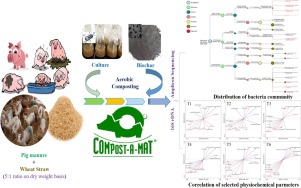当前位置:
X-MOL 学术
›
J. Hazard. Mater.
›
论文详情
Our official English website, www.x-mol.net, welcomes your
feedback! (Note: you will need to create a separate account there.)
Emerging applications of biochar: Improving pig manure composting and attenuation of heavy metal mobility in mature compost.
Journal of Hazardous Materials ( IF 12.2 ) Pub Date : 2020-01-17 , DOI: 10.1016/j.jhazmat.2020.122116 Mukesh Kumar Awasthi 1 , Yumin Duan 1 , Sanjeev Kumar Awasthi 2 , Tao Liu 2 , Hongyu Chen 2 , Ashok Pandey 3 , Zengqiang Zhang 2 , Mohammad J Taherzadeh 4
Journal of Hazardous Materials ( IF 12.2 ) Pub Date : 2020-01-17 , DOI: 10.1016/j.jhazmat.2020.122116 Mukesh Kumar Awasthi 1 , Yumin Duan 1 , Sanjeev Kumar Awasthi 2 , Tao Liu 2 , Hongyu Chen 2 , Ashok Pandey 3 , Zengqiang Zhang 2 , Mohammad J Taherzadeh 4
Affiliation

|
This study evaluated the effect of integrated bacterial culture and biochar on heavy metal (HM) stabilization and microbial activity during pig manure composting. High-throughput sequencing was carried out on six treatments, namely T1-T6, where T2 was single application of bacteria culture (C), T3 and T5 were supplemented with 12 % wood (WB) and wheat-straw biochar (WSB), respectively, and T4 and T6 had a combination of bacterial consortium mixed with biochar (12 % WB and 12 % WSB, respectively). T1 was used as control for the comparison. The results show that the populations of bacterial phyla were significantly greater in T6 and T4. The predominate phylum were Proteobacteria (56.22 %), Bacteroidetes (35.40 %), and Firmicutes (8.38 %), and the dominant genera were Marinimicrobium (53.14 %), Moheibacter (35.22 %), and Erysipelothrix (5.02 %). Additionally, the correlation analysis revealed the significance of T6, as the interaction of biochar and bacterial culture influenced the HM adsorption efficiency and microbial dynamics during composting. Overall, the integrated bacterial culture and biochar application promoted the immobilization of HMs (Cu and Zn) owing to improved adsorption, and enhanced the abundance and selectivity of the bacterial community to promote degradation and improving the safety and quality of the final compost product.
中文翻译:

生物炭的新兴应用:改善猪粪堆肥和降低成熟堆肥中重金属的迁移率。
这项研究评估了整合的细菌培养和生物炭对猪粪堆肥过程中重金属(HM)稳定性和微生物活性的影响。高通量测序在T1-T6六种处理中进行,其中T2是单次细菌培养(C),T3和T5分别补充了12%的木材(WB)和麦秸生物炭(WSB) ,T4和T6的细菌联合体与生物炭混合在一起(分别为12%WB和12%WSB)。T1用作比较的对照。结果表明,在T6和T4中细菌门的数量显着增加。最主要的门类是Proteobacteria(56.22%),Bacteroidetes(35.40%)和Firmicutes(8.38%),优势属是Marinimicrobium(53.14%),Moheibacter(35.22%)和Erysipelothrix(5.02%)。此外,相关分析揭示了T6的重要性,因为生物炭和细菌培养物的相互作用会影响堆肥过程中的HM吸附效率和微生物动力学。总体而言,整合的细菌培养和生物炭应用由于改善了吸附而促进了HMs(铜和锌)的固定化,并增强了细菌群落的丰度和选择性,从而促进了降解并提高了最终堆肥产品的安全性和质量。
更新日期:2020-01-17
中文翻译:

生物炭的新兴应用:改善猪粪堆肥和降低成熟堆肥中重金属的迁移率。
这项研究评估了整合的细菌培养和生物炭对猪粪堆肥过程中重金属(HM)稳定性和微生物活性的影响。高通量测序在T1-T6六种处理中进行,其中T2是单次细菌培养(C),T3和T5分别补充了12%的木材(WB)和麦秸生物炭(WSB) ,T4和T6的细菌联合体与生物炭混合在一起(分别为12%WB和12%WSB)。T1用作比较的对照。结果表明,在T6和T4中细菌门的数量显着增加。最主要的门类是Proteobacteria(56.22%),Bacteroidetes(35.40%)和Firmicutes(8.38%),优势属是Marinimicrobium(53.14%),Moheibacter(35.22%)和Erysipelothrix(5.02%)。此外,相关分析揭示了T6的重要性,因为生物炭和细菌培养物的相互作用会影响堆肥过程中的HM吸附效率和微生物动力学。总体而言,整合的细菌培养和生物炭应用由于改善了吸附而促进了HMs(铜和锌)的固定化,并增强了细菌群落的丰度和选择性,从而促进了降解并提高了最终堆肥产品的安全性和质量。











































 京公网安备 11010802027423号
京公网安备 11010802027423号